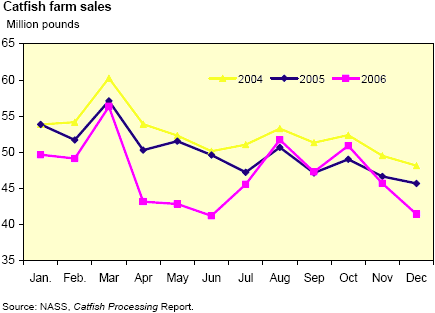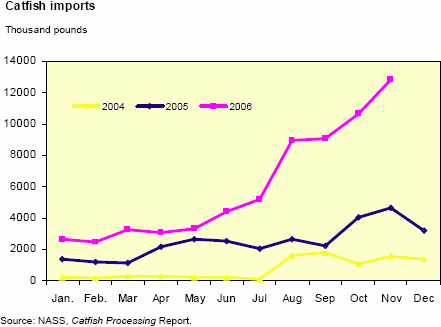
Catfish Sales Expected To Decline in 2007
Catfish: Catfish sales by growers to processors are expected to decline in 2007 for the third consecutive year, but the smaller supplies are expected to keep farm and processor prices at relatively high levels. Grower estimates of inventories in ponds at the beginning of 2007 showed declines in almost all categories despite 2 consecutive years of relatively strong prices. The lower inventories in all categories point strongly towards lower sales of foodsize fish to processors in 2007. Processed catfish sales volume fell by 5.4 percent in 2006, but it was more that offset by an 8.3-percent increase in the average price to $2.48 per pound.
Farmer sales of catfish to processors are expected to decrease slightly to between 545 and 555 million pounds in 2007. Based on grower estimates of inventories at the beginning of January 2007, grower sales are expected to be lower during the first part of 2007 compared with a year earlier. Second-half grower sales are expected to be closer to—but still below—their year earlier level. Grower prices are expected to remain strong through the year, with somewhat higher prices in the first part of 2007.
Sales by catfish growers of all products totaled $480.8 million in 2006, down slightly from the previous year. The decline was due to lower sales of broodfish and fingerlings, as total sales of foodsize fish were $452 million, a small increase from 2005. Total revenues from foodsize fish sales were up slightly in 2006. The increase was due to higher prices, as the total poundage of foodsize fish sold declined 9 percent from the previous year to 583.6 million pounds. Average farm prices for foodsize fish rose to 77 cents per pound, up 7 cents (10 percent) from 2005.
Direct sales of foodsize fish by farmers to processors are reported monthly in the Catfish Processing report. These sales totaled 565 million pounds in 2006, down 5.9 percent from 2005 and the third consecutive annual decline in sales. The peak in sales was in 2003, at 661 million pounds. Monthly sales volumes from catfish growers to processors were below those of 2005 throughout most of the year, but, higher farm-level prices offset the decline in sales volume. Farm-level prices for foodsize fish have risen in the last 4 years after averaging only 56.8 cents per pound in 2002. The average price in 2006 was 79.6 cents per pound, up 9.8 percent from the previous year. Monthly farm prices were strong throughout 2006, being higher than the previous year in almost every month.


Processor sales of catfish products have followed basically the same pattern as grower sales of catfish to processors. Sales of catfish products reached a peak in 2003 of 319 million pounds and have fallen in the last 3 years. As with farm sales, while the sales volume has declined, the weighted average price of catfish products has risen. In 2006, the average price for catfish products was $2.48 per pound, 8.3 percent higher than in 2005. Gross returns to catfish processors were $704 million in 2006, up 2.5 percent from $687 million in 2005.
Grower sales of catfish over the first half of 2007 are expected to be influenced by a number of factors. First, the water acreage available for growing catfish is expected to be lower as some smaller producers leave the business. Second, grower estimates of inventory levels of all sizes of catfish (foodsize, stockers, and fingerlings) are down. Third, catfish growers, like producers of livestock and poultry, will be faced with much higher feed costs as prices for corn and soybean meal increase. Lastly, imports of frozen fillets from fish that can be substituted for catfish are likely to continue to increase.
Catfish Feed Deliveries Unchanged in 2006
There are now 3 years of monthly feed delivery data available from the Catfish Feed Deliveries report. In 2006, feed deliveries for foodsize fish totaled 727,000 tons, up marginally from the previous year. This is surprising considering that grower sales of foodsize fish declined by over 50 million pounds in 2006. Deliveries of feed for fingerlings and broodfish were consistently higher throughout 2006 and totaled 48,000 tons, up 29 percent from 2005. Of the four major catfishproducing States (Mississippi, Alabama, Arkansas, and Louisiana), feed deliveries in Mississippi and Arkansas showed small gains and deliveries in Alabama and Louisiana declined significantly.
Since catfish growth rates and feed requirements are closely tied to increasing water temperatures, the majority of feed use comes during June to September. Feed deliveries for foodsize fish in these months in 2006 totaled 488,000 tons (67 percent of the feed usage for the year). Monthly feed deliveries for the year ranged from 139,000 tons in August to only 5,100 tons in January. The feed usage pattern is basically the same for fingerlings and broodfish.
Catfish Inventories Down
Grower estimates of catfish inventories held in ponds at the beginning of 2007 showed declines in almost all categories, despite 2 consecutive years of relatively strong prices. The lower inventories for all sizes point strongly toward lower sales of foodsize fish to processors in 2007. With continued growth in the domestic economy expected, along with stronger prices for most poultry products, the reduced catfish production is expected to result in continued high prices at both the farm and wholesale levels.
Grower estimates of foodsize fish inventories at the beginning of 2007 were approximately 311 million fish, down 5 percent from the same period in 2006. There were major reductions in foodsize inventory holding in all the major catfishproducing States. There is a difference between the estimates of inventory holding and sales of fish to processors or other outlets, as the percentage of animals lost to disease and predation is much higher for catfish than in the other livestock industries.
In this case, the grower inventory estimates at the beginning of the year were 311 million fish and stocker and fingerling estimates were an additional 1.5 billion fish, while actual sales of foodsize fish in 2006 were only 369 million. The foodsize fish inventories at the beginning of the year make up the bulk of fish sold by growers during the first 4-5 months of the year, until the peak growth period in the summer. This means that catfish farmers are expected to have a smaller number of fish available for sale during this period compared with 2006.
The January 1, 2007, inventory estimate for stockers showed an 8-percent decrease from a year earlier. Grower estimates for stocker inventories at the start of the year have varied considerably over the last several years, with the 2006 estimate being 21 percent higher than in 2005. In 2007, the bulk of the stocker inventory decline was in Alabama and Arkansas, with inventory estimates rising strongly in Mississippi. The inventory estimate for fingerlings was also down approximately 8 percent compared with the previous year. Again, most of the decline was in Alabama (down 106 million) and Arkansas (down 28 million), with inventory estimates for Mississippi rising by over 70 million fish. Fish in the stocker and fingerling classes at the beginning of 2007 are likely to provide the bulk of the fish sold to processors in the second half of the year. The decline in the number of fish in both categories indicates that farm prices are expected to remain strong throughout most of the year.
Pond Acreage Down Again
The NASS Catfish Production report indicated that growers would have around 160,000 acres of ponds in catfish production during the first half of 2007, down 6,700 acres from 2006 and the fifth consecutive annual decrease. Estimated pond acreage for the first half of 2007 is lower for foodsize fish and broodfish, but higher for fingerlings. Curiously, growers in Alabama stated they expected to have an additional 400 acres in fingerling ponds in the first half of 2007, but grower estimates of their fingerling inventories as of the first of the year were down by 106 million fish (64 percent). In addition, growers indicated that both the amount of rebuilt pond acreage and new construction are expected to be lower than in the previous year.
Processor Revenues Rise in 2006
Even though processor catfish sales volume fell by 5.4 percent in 2006, an 8.3- percent increase in the average price, to $2.48 a pound, helped to offset the impact. Gross catfish processor revenues increased to over $700 million, up 2.5 percent from 2005. In 2007, sales volume is expected to decrease slightly, but prices are expected to remain strong or even increase slightly. Thus, total gross processor revenues are expected to remain close to the 2006 level.
Imports of frozen catfish or fish that can be substituted for domestic catfish rose strongly again in 2006. The import estimates reported by NASS in the Catfish Processing report, totaling 66 million pounds over the first 11 months of 2006, were up 146 percent from the same period in 2005. Imports include freshwater imports of Ictalurus spp., Pangasius spp., and catfish of the order Siluriformes. This compares with 118 million pounds of frozen catfish fillets sold by domestic processors. In 2006, sales of frozen catfish fillets by domestic processors were down by almost 5 percent, but the fish were sold at prices almost 10 percent higher than in 2005, $2.93 per pound. Over the previous decade, frozen fillets had been the largest source of expanding sales for domestic catfish processors.
The overall outlook for catfish producers and processors in 2007 is mixed. With lower grower inventories at the start of the year, farm supplies of catfish are expected to remain tight, supporting relatively high farm prices. On the processing side, catfish sales will benefit from an expected slowdown in growth in poultry production. Also, the forecast is for continued growth in the domestic economy which is expected to boost restaurant sales and purchases of food away-from-home. On the negative side, margins for catfish growers and processors will be pressured by much higher feed costs in 2007 and continued competition from imported catfish substitutes.

Further Information
For more information view the full Livestock, Dairy and Poultry Outlook - February 2007 (pdf)February 2007

